The Acropolis of Athens Old Museum
IntroductionThe Museum existing until lately on the Acropolis rock was considered among the most important ones in the world and definitely the most important one as far as the History of European Art is concerned. It was built on the Acropolis Hill in 1874, in such a way that it would not aesthetically interfere with the Temples, nor be visible from anywhere within the city of Athens.
The excavations that followed, toward the end of the 19th century, unearthed a wealth of finds which were impossible to exhibit in the limited space of the Museum. Thus, the inscriptions, bronzes, clay objects, and a variety of other items were kept in the National Archaeological Museum, where they were originally taken for conservation. The situation was aggravated after all the marble pieces were removed from the Parthenon Friezes (that is, what was left over after Elgin's plunder) and were put in the museum, together with the Caryatids (the marble statues of the women supporting the roof of the south porch of the Erechtheion), all of which were removed to be kept in an air-tight window containing nitrogen, so as to stop air pollution from deteriorating the marble surfaces.
The collections of the museum included:
Sculptural offerings of the Archaic period
Pediments of temples dated to the Archaic period
Archaic Horsemen
Sculptures of the "Severe" style
Pediments and metopes from the Parthenon
The Parthenon frieze
The Erechtheion frieze
Parapets of the Athena Nike temple
Frieze of the Athena Nike temple
The Caryatids
Clay figurines and vases from the sanctuary of the Nymphs.
Everyone was eagerly anticipating the completion of the new Acropolis Museum, for the total wealth of finds related to the Acropolis and the Parthenon to finally be exhibited in the best possible way (combining location, lighting, space, air filtering and thematic consistency), and thus deprive the descendants of Lord Elgin of all plausible excuses to insist that the Parthenon Marbles continue to be kept separated from the rest of their like and the Parthenon remain in its mutilated state.
During 2008, the exhibits of this Museun were transferred to the New Museum, the erection of which was completed. Three huge cranes were used to carry all the heavy marble statues and exhibits, a total of some 4,500 artifacts from the old, cramped Acropolis museum, a task that was the biggest airlift of antiquities in Greek history. It was the first time the artifacts — some of which are considered among the most important works of antiquity — were moved from the very Acropolis Rock. This transfer was completed in the end of spring but putting up the exhibits in their right place would take a lot longer.
We thought that the present Album would become useless after the New Museum's inauguration. Nevertheless, the decision of the museum authorities to prohibit taking photographs of the exhibits in their new surrounding created more problems than the ones it was supposed to solve. We admit that the decision was well meant, but, with all due respect, we would like to point out that times have changed; we are afraid that whatever is not shown online cannot achieve the level of promotion that it may be worthy of. We managed, though, to get a number of photos of the exhibits, as the decision was taken a couple of weeks after the museum's inauguration. We are working on them and will do our best to put them up as soon as possible. But, in our effort to best present the exhibits, we are sorry to have to use some of the photos taken at the Old Acropolis Museum. Until the New Acropolis Museum album is online, please enjoy the marvellous artifacts at their old "home".
(Photos: Michael Tziotis)
Select Page of the Album:
Click on any of the pictures to enlarge.
Gallery V: The Athena Nike Temple FriezeThe Athena Nike temple is a building of Ionic order with four columns at each porch, built between 427 and 424 B.C. on the basis of the drawings by the architect Kallicrates. The relief frieze ran along all four sides of the temple just below the cornice; the original length is estimated at 25.94 meters.
The frieze was made up of fourteen blocks 0.45 m high and 0.40 m wide, seven of which were reset in place during the second restoration of the temple. Cement copies replaced the four blocks which had been incorporated in the Turkish bastion and were removed by Elgin, cut down to a thickness of 0.12m (!) and sold to the British Museum.
Neither the precise disposition of the blocks nor the reconstruction of the composition of the frieze reliefs is absolutely certain. Not only is the sequence of the blocks on the west, north and south sides in doubt, but also the interpretation of the representation as a whole.
The assembly of the Olympian gods is shown on the east frieze and the other three sides depict battle scenes, in which the opponents are distinguished by means of their garments. A number of Persian warriors are wearing long-sleeved “chitons” and trousers. The Greek hoplites are either naked or wear short “chitons” and cloaks fluttering in the breeze; sometimes hey carry round shields and fight in groups over the bodies of fallen or dead warriors. Some combatants are mounted and there are two horses without riders.
The dynamic realism of the battle scenes is particularly striking: the figures are shown in a variety of poses, often with their backs to the spectator, so as to create an illusion of depth. Sections of the frieze have been attributed to different craftsmen working under the overall guidance of probably the sculptor Agorakritos, Pheidias’ pupil, whose style is recognized on the east frieze.
The battle scenes have been variously interpreted, as wars between the Athenians and their enemies; or mythical events, such as the Trojan War; or historical events, such as the Battle of Marathon in 490 B.C., or the Battle of Plataia in 479 B.C.
In 1998 the frieze was taken down from the temple, in order to protect and conserve it. Exhibiting the frieze in the Acropolis Museum greatly facilitates the study of the arrangement of the blocks, the development of the compositions and the interpretation of the subject-matter.
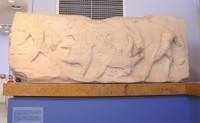
The Athena Nike Temple Frieze: The Southern Face of the Southwest Corner Block
This block face depicts four figures and a horse. In the center the horse rears up on its hind legs, violently unseating his Persian rider who flings out one hand to break his fall, as he is attacked from both sides by two hoplites. |
|
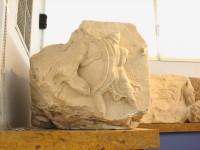
The Athena Nike Temple Frieze: The western Face of the Southwest Corner Block
This western face shows two warriors, each attempting to repel the other man’s attack by shoving him over with his shield. The hoplite on the left charges to the right; his opponent wearing a shield and conical helmet is seen from the back by the spectator. |
|
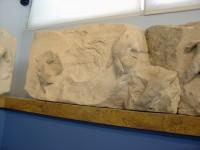
The Athena Nike Temple Frieze: The fourth block of the south frieze
The fourth block of the south frieze is preserved in two pieces connected by a small joining fragment.
At the left is a group of three figures: a hoplites, fallen on one knee, attempts to ward off the attack of a Persian, a second hoplites shown in frontal pose and a Persian kneeling on the ground. |
|
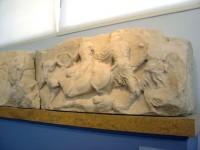
The Athena Nike Temple Frieze: The fourth block of the south frieze
The fourth block of the south frieze is preserved in two pieces connected by a small joining fragment.
The right hand section has a group of figures around a horse. The wounded horse falls to its knees and its rider is being forced to dismount. A fallen Persian lies dead on the ground. Behind the horse are three Persians: two of them are moving forward to attack and the third, preserved fragmentarily, is falling down backwards. |
|

The Athena Nike Temple Frieze: The East Frieze
The east side of the frieze consists of four blocks, three of which are preserved: The southeast corner block and the two central blocks. The right edge of the third block and the northeast corner block are lost. An Assembly of the Gods is represented with 24 figures – originally there would have been 27 or 28 figures. The composition is symmetrically developed on either side of the central figure, Athena. Proceeding from left to right, the figures are as follows: On the southeast corner block Peitho, Eros and Aphrodite. On the second block three dancing women, Charites or Seasons; a fragmentary seated figure, probably Hestia; Leto, Apollo and Artemis; a male figure leaning on a staff, probably Theseus and Amphitrite in front of Poseidon seated on a rock. The third block was Athena holding a shield and the legs of a male figure, probably Ares, in front of Zeus seated on a stool; Hera standing beside Zeus drawing her “himation” away from her face; Hephaistos, Hekate, Demeter and Kore. Lastly a group of three female figures, the central one seated and has been variously tentatively identified as Moira, a Nymph, Thetis, Themis, and Pandrosos. |
|
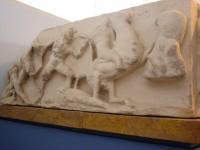
The Athena Nike Temple East Frieze: The South Face of the Southeast Corner Block
The south face of the southeast corner block depicts, from left to right, a complex of two hoplites, one of which is kneeling to the ground, wounded, while his fellow warrior is helping him. In the middle, a hoplite, wearing a helmet and carrying a shield (hoplon in ancient Greek), is attacking with his spear a Persian rider, whose horse has bolted and is standing up on its hind legs. On the ground, just under the two opponents, a Persian warrior lies dead. To the right, another Persian fighter turns to the rider, showing his back to the spectator.
|
|
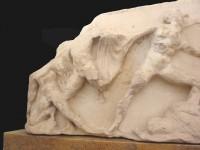
The Athena Nike Temple East Frieze: The South Face of the Southeast Corner Block (Left Half) |
|
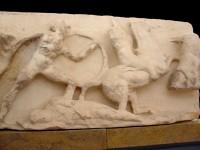
The Athena Nike Temple East Frieze: The South Face of the Southeast Corner Block (Right Half) |
|
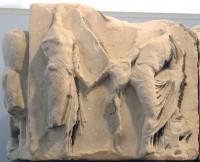
The Athena Nike Temple East Frieze: The Southeast Corner Block (East Face)
Peitho, Eros and Aphrodite |
|

The Athena Nike Temple East Frieze: Fist Block of the Two Central Ones |
|
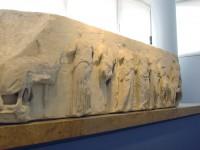
The Athena Nike Temple Frieze: The East Frieze (The Northernmost Part Preserved)
This is the Northernmost part of this frieze preserved: it starts with Zeus seated on a stool; Hera is standing beside Zeus drawing her “himation” away from her face; next, there are Hephaistos, Hekate, Demeter and Kore. Lastly a group of three female figures, the central one seated; she has been variously tentatively identified as Moira, a Nymph, Thetis, Themis, and Pandrosos. |
|
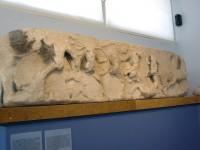
The Athena Nike Temple Frieze: The North Frieze
One of the central blocks is preserved almost intact and the northwest corner block fragmentarily. Battle scenes between naked hoplites and warriors wearing “chitons” are depicted on both blocks.
On the north side block hoplites are shown, two of which are fallen on the ground and two are vigorously attacking their opponent. The enemy must be an important figure to judge by his positioning in the center of the composition, and his attire: “chiton”, “chlamys” and helmet. As the warrior attempts to flee, his helmet falls off and two hoplites seize him, one grasping his shoulder, the other grabbing him by the beard. At the right two horses turn to flight, his fellow warrior lies dead on he ground. The composition is variously interpreted as a scene from the Trojan War (Achilles and Memnon), as a battle between Athenians and Boeotians or as an Athenian victory in a cavalry battle with Masistios, second-in-command under Mardonius at the Battle of Plataiae. |
|

The Athena Nike Temple Frieze |
|
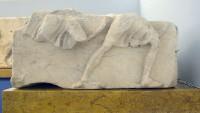
The Athena Nike Temple Frieze |
|
Select Page of the Album:
|
|



